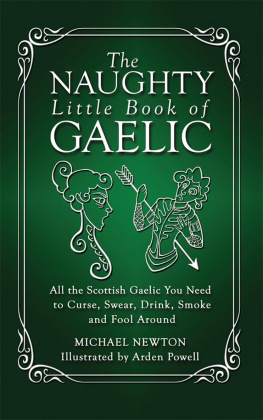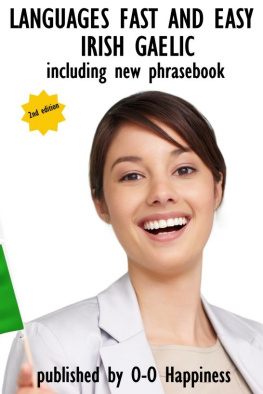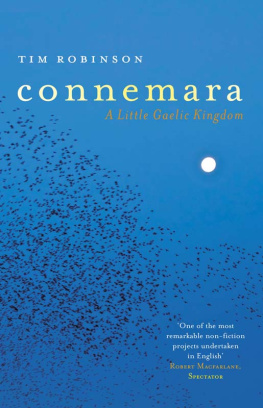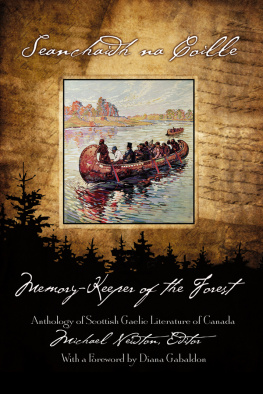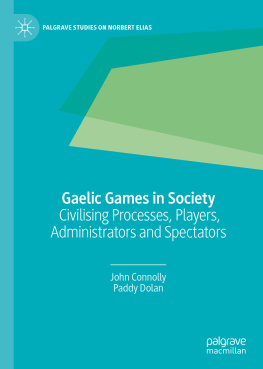THE
SCOTTISH GAELIC
TATTOO
HANDBOOK
Authentic words and phrases
in the Celtic language
of Scotland
by
Emily McEwan

Bradan Press
Halifax, Nova Scotia
Copyright 2016 by Emily McEwan
All rights reserved. No part of this publication maybe reproduced, distributed, or transmitted in any form or by anymeans, including photocopying, recording, or other electronic ormechanical methods, without the prior written permission of thepublisher, except in the case of brief quotations embodied incritical reviews and certain other noncommercial uses permitted bycopyright law. For permission requests, contact the publisher atthe e-mail address below.
Bradan Press
Halifax, Nova Scotia, Canada
http://www.bradanpress.com
info@bradanpress.com
Disclaimer: This book is designed to provideinformation only. The author and publisher shall have no liabilityor responsibility to any person or entity regarding any loss ordamage incurred, or alleged to have incurred, directly orindirectly, by the information contained in this book.Additionally, while the author and publisher have made every effortto ensure the accuracy of the information within this book at timeof publication, the author and publisher do not assume and herebydisclaim any liability to any party for any loss, damage, ordisruption caused by errors or omissions, whether such errors oromissions result from accident, negligence, or any other cause.
Library and Archives Canada Cataloguing inPublication
McEwan, Emily, author
The Scottish Gaelic tattoo handbook : authentic words
and phrases in the Celtic language of Scotland / by EmilyMcEwan.
Includes bibliographical references and index.
Issued in print and electronic formats.
ISBN 978-0-9950998-0-7 (paperback).--ISBN 978-0-9950998-3-8
(pdf).--ISBN 978-0-9950998-2-1 (mobi).--ISBN978-0-9950998-1-4
(epub)
1. Scottish Gaelic language--Handbooks, manuals,etc.
2. Scottish Gaelic language--Terms andphrases--Handbooks,
manuals, etc. 3. Scottish Gaelic language--Glossaries,vocabularies
, etc.--Handbooks, manuals, etc. 4. Tattooing--Handbooks, manuals
, etc. 5. Words in art--Handbooks, manuals, etc. I. Title.
PB1514.M34 2016 491.6'3 C2016-902769-4
C2016-903449-6
Front and back cover illustrations copyright 2016 byPat Fish
Pat Fish is known internationally for herCeltic tattoo art, bringing the ancient illuminatedmanuscripts and patterns from standing stones alive in skin. Viewher work at:
http://www.luckyfish.com and http://www.luckyfishart.com .
Back cover author photo copyright 2016 by RebeccaClarke, http://www.rebeccaclarke.ca
Figures copyright 2016 by Emily McEwan-Fujita
Gaelic editors:
Marcas Mac an Tuairneir, www.marcasmac.co.uk
Angus MacLeod, St. Anns Bay, Nova Scotia, Canada
Table of Contents
Introduction
People have many different reasons forgetting a tattoo with a word or phrase in Scottish Gaelic. Perhapsyour parents or grandparents spoke Gaelic and the language remindsyou of them. Maybe your ancestors emigrated from a Gaelic-speakingarea of Scotland and the language symbolizes your familyhistory.
Many people relate to Gaelic on a symboliclevel as well. If you are Scottish or of Scottish heritage, you maysee Gaelic as a symbol of Scotland. Gaelic is also a Celticlanguage, and for many people Celtic art and culture hold greataesthetic and even spiritual appeal.
Whatever the reason you want a tattoo, youare in charge of getting it right. A good tattoo artist will adviseyou to do your research before you get a tattoo that incorporateswords or symbols from another language or culture. For example, PatFish is a tattoo artist in Santa Barbara, California whospecializes in Celtic design. Pat includes the following section onher release form which clients must initial:
If the tattoo has an element that is written in alanguage other than English, Tattoo Santa Barbara takes noresponsibility for the accuracy of that text. It is the clientsresponsibility alone to check for the correct words and spelling orsymbols.
In other words, you are solely responsiblefor the non-English content of your tattoo. However, finding asuitable Gaelic phrase and confirming its accuracy is not easy. Infact, getting a tattoo in a language you dont understand is risky,especially in the internet age.
Social media sites regularly share storiesand photos about people with embarrassing tattoo mistakes in otherlanguages. People have gotten tattoos with Chinese charactersbackwards or upside down, or ones that read rice fried in porkfat or meanie crime poet.
One American man in Arkansas got a giantHebrew tattoo on his forearm that he thought meant strength butactually meant matzo, the unleavened cracker-like bread eaten atJewish Passover celebrations. People have tried to get Christiantattoos in Hebrew that end up mangling the name of the very Godthey are trying to honour.
This book can save you from making similartattoo mistakes in Gaelic. It offers real-life examples,professional linguistic insight, advice from a Gaelic-speakingperspective, and a list of ready-made translations.
This book does not contain any tattooartwork. Once youve settled on your preferred wording, you canbring it to a tattoo artist and work with him or her to incorporateit into a design of your choice.
Readers are invited to explore the art ofPat Fish, the creator of this books cover art. Pats website http://www.luckyfishart.com features a wide range of Celtic art tattoo designs. Readers may usethe coupon code GAELIC2 to receive a discount on the purchase ofher tattoo designs, including a version of the lion featured on thefront cover.
Professionally designed tattoo imagescombined with an accurate Gaelic word or phrase will give you atrue work of art: one uniquely suited to you, that communicates inboth beautiful images and meaningful words.
Chapter1
What is ScottishGaelic?
For most English speakers, even basicinformation about Scottish Gaelic is not well understood. Thischapter offers some of the most important facts to know aboutGaelic before you choose to incorporate a word or phrase into atattoo. These facts are divided into two main areas: the historyand present-day situation of the language, and basic linguisticknowledge.
History and current situation
Gaelic is often called an ancientlanguage, but the poetic claim that it was spoken in the Garden ofEden should not be taken literally. Most scholars agree that Gaelicwas first brought to Scotland from Ireland around the 4th or 5thcentury CE, though some scholars have argued that it may havedeveloped much earlier, concurrently in Scotland and Ireland. Untilabout the 8th century, Gaelic was spoken mainly in the Kingdom ofDl Riata on the west coast. Gaelic spread throughout the westernand northern areas of what became the Kingdom of Alba between 800and 1100 CE. The Gaelic linguistic area started to shrink from the12th century onward, and by 1400 Gaelic was no longer the mainlanguage of Scotland, although it has continued to be spoken inScotland ever since.
At present, Gaelic is considered one of theworlds lesser-used languages, languages which are still livingbut are spoken by relatively smaller numbers of people.
Gaelic may seem like a mysterious languageto those who are not already part of a Gaelic community. For Gaelicspeakers themselves, though, the language is not mysterious; it isjust a part of everyday life. It is still hidden in a sense,because of how thoroughly it was neglected and discouraged byBritish, Scottish, and Canadian institutions including governments,schools, the church, and ultimately many speakers themselves. Theresult is that in most places these days, even in Gaelic-speakingareas, one does not simply walk out the front door and hear thelanguage. In other words, you have to know where to find Gaelicspeakers and how to engage with them.



